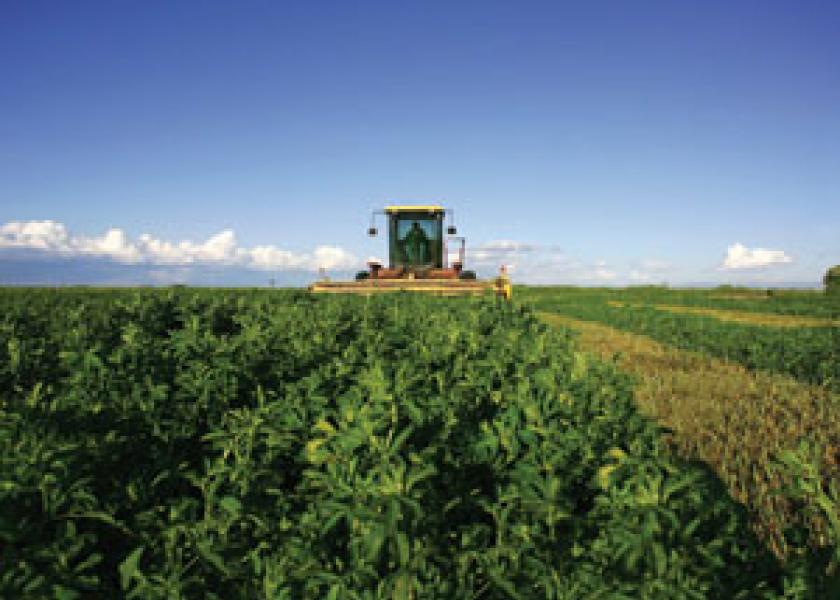Excellent Forage Starts with Planning, Not the Finished Product: Variety Selection

By: Phil Kaatz, Michigan State University Extension
Although the calendar says spring has arrived, the hot topic of discussion by most farmers will probably get to the weather forecast faster than you can say, "A long, hard winter." Many farmers may have already purchased their forage seed for spring planting based on rotations or the need for livestock feed. However, spending time to evaluate alfalfa varieties is a crucial decision that has a direct influence on the bottom line. In addition to yield, there are other valuable selection criteria that producers should consider when looking at their seed needs and planting intentions.
Forages are an integral part of agricultural systems and producer goals may include improving soil health and structure, providing wildlife and beneficial insect habitat, improving water retention and protecting water quality. The best seed varieties will differ across these different goals, so it’s a vital decision point in planning. Excluding fertility, it’s the decision where farmers can have the most influence, so they should carefully choose the best seed variety for optimum economic and environmental impact.
To select the right alfalfa variety to meet the goals of your system, the main areas to consider include:
- Length of time in the rotation
- Yield
- Disease resistance
- Variety traits
Short-term or long-term stand life
Winterhardiness is the primary evaluation to determine whether a variety will survive in a long-term stand. A short-term stand in Michigan (three to four years) should have varieties that are at least moderately winter hardy. Winter hardiness is closely tied to the dormancy of the variety. Group 2 dormancy would be considered winter hardy and is more long-lived than a moderately winter hardy variety with a dormancy group rating of 3 or 4. Producers should realize that the number of cuttings is clearly related to the group dormancy rating. The higher the rating, the more cuttings will be possible along with reduced stand longevity.
High yield
Michigan State University Extension alfalfa variety trials show that the top producing varieties can yield as much as 142 percent of the check. The average of all varieties tested showed an increase of 111 percent of the check. As an example, in a high fertility environment, if the check variety yielded 5 tons per acre, the average of all other varieties would be over a half ton alfalfa more per year per acre. Given a current price range of $225-$250 per ton for high quality alfalfa, this would equal $130 per acre per year. This more than makes up for any price difference in seed between the highest and lowest yielding varieties.
Disease resistance
The alfalfa varieties that are sold today have gone through evaluations to determine levels of resistance to diseases. The diseases for which varieties are screened include:
- Bacterial wilt
- Phytophthora root rot
- Anthracnose
- Verticillium wilt
- Aphanomyces (APH) race 1 and 2
- Stem/bulb nematode
Alfalfa producers should be aware that alfalfa seedlings can be susceptible to Phytophthora root rot and Pythium even though they may be resistant as mature plants, and that selection for disease resistance never guarantees complete protection from disease loss.
Variety traits
Alfalfa varieties are available with a variety of technology traits designed to fit specific needs that are relevant to Michigan. Glyphosate-tolerant alfalfa, patented as Roundup Ready, is a technology that enables applications of the broad-spectrum herbicide Roundup or its equivalent for weed control without harming the alfalfa crop. Potato leafhopper resistance is imparted by multiple factors, including sticky leaf hairs that bar feeding by nymphs and adults of the insect. Varieties with the branched root trait will tolerate wetter conditions and should be considered if field drainage is marginal. However, alfalfa is never a good forage choice for a poorly drained field. Varieties with the StandFast trait exhibit improved standability and fast regrowth for high yields with less harvest loss to lodging.
Whatever the circumstances are for your farm, careful consideration of the seed options should be analyzed to insure you get the best variety to meet your specific goals. Because the status of many alfalfa fields regarding winterkill will be determined in the next few weeks, if there are problems, planting intentions may change dramatically and alfalfa seed demand will quickly escalate. Waiting until the last minute may result in the variety you want being sold out or low in inventory and unavailable. If this happens, producers should have a plan in place if the variety they want is not available.
To find a complete list of alfalfa varieties tested in Michigan, go to the 2013 Michigan Forage Variety Test Report. Plan ahead and pay attention to detail to ensure you have the best results possible.







